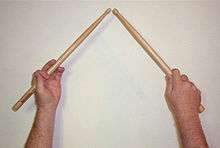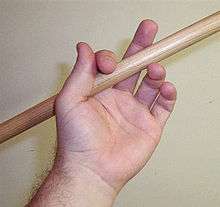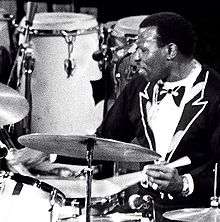Traditional grip
Traditional grip (also known as orthodox grip or conventional grip and, to a lesser extent, the jazz grip) is a technique used to hold drum sticks while playing percussion instruments. Unlike matched grip, each hand holds the stick differently. Commonly, the right hand uses an overhand grip and the left hand uses an underhand grip. Traditional grip is almost exclusively used to play the snare drum, especially the marching snare drum, and often the drum kit. Traditional grip is more popular in jazz drumming than in other drum kit styles due to the early jazz drummers evolving their style from marching and military styles and instrumentation,[1] although it is also used by several rock drummers.




This grip is called traditional because it descends from military marching drummers who carried a snare drum on a sling hung from the neck or one shoulder, with the drum riding closer to one hip than the other and tilted slightly for easier reach. This allowed the drummer to play the drum and march without banging his knees or thighs into the drum. Because of that drum position, using an overhand grip on the high (left) side of the drum would force the elbow into a very awkward position while an underhand grip is much more comfortable. Even when the drum is on a stand, many drummers will tilt their drum when using traditional grip. Although tilting is not required, it helps align the shoulders and spine and is more ergonomic. Many drummers use traditional grip on drums that are perfectly horizontal, especially in marching percussion.
With the underhand grip, there are several different techniques employed which involve slight variations in finger positioning and usage. Common with all techniques is the usage of the wrist in rotating (a motion like turning a door knob) as the fundamental motion of the stick. Once the stick has started moving, more involved techniques require the exclusive use of the thumb for bouncing the stick when playing at a faster tempo. The stick then rests in the space between the thumb and index finger, and the two fingers close around the stick with the thumb atop the index at the first knuckle. The middle finger then rests slightly on the top side of the stick (typically the side fingertip is the only contact made). The stick then rests on the cuticle of the ring finger with the little finger supporting the ring finger from below.
Sanford A. Moeller (whose book discusses the Moeller method or Moeller technique) suggests that one should learn the traditional grip 'ancient style', as well ... where the overhand grip should hold or grip the drumstick almost entirely with the little finger.[2]
Scottish pipe band players have a variation on the traditional left hand grip in which the underhand grip is played entirely with the thumb on top of the stick, utilizing no other fingers for downward pressure.[3] This suits the pipe band’s light and snappy style of playing well, but is not as suitable for American style drum corps playing or jazz drumming on a full kit.
Traditional grip can also be useful when playing with brushes in a stirring motion. Normally this style is used in a jazz context. The underhand grip naturally angles the left hand farther away from the right hand than would matched grip and allows more room for crossovers and sweeping maneuvers across the surface of the drum.
Physiologically, the traditional left underhand hand grip uses fewer muscles than the right overhand grip and this causes each muscle to do a larger percentage of the work.[4] Matched grip is therefore technically easier to play, though for reasons stated above, not always the superior choice for every application.
Prominent traditional grip drummers
Prominent drummers who used or use the traditional grip include:
- Dannie Richmond
- Buddy Rich
- Gene Krupa
- Max Roach
- Art Blakey
- Kenny Clarke
- Jo Jones
- Joe Morello
- Elvin Jones
- Philly Joe Jones
- Louie Bellson
- Jimmy Cobb
- Roy Haynes
- Tony Williams
- Charlie Watts of The Rolling Stones
- David Lovering of The Pixies
- Mick Avory of The Kinks
- Levon Helm of The Band
- Karen Carpenter of The Carpenters
- Rick Allen (before loss of arm) of Def Leppard
- Cozy Powell
- Mitch Mitchell
- Clyde Stubblefield
- B. J. Wilson of Procol Harum
- Jason Costa of All That Remains
- Brian Chase of Yeah Yeah Yeahs
- Carl Palmer of Emerson, Lake & Palmer
- Nick Pierce, formerly of The Faceless and Culling the Weak
- Bob Siebenberg of Supertramp
- Ziggy Modeliste of The Meters
- Stewart Copeland of The Police
- Billy Doherty of The Undertones
- Michael Shrieve of Santana
- Doug Clifford of Creedence Clearwater Revival
- Mel Taylor of The Ventures
- Billy Ficca of Television & The Waitresses
- Aaron Comess of Spin Doctors
- Carla Azar of Autolux
- Matt Chamberlain
- Daru Jones
- Evan Walsh of The Strypes
- Bruno Valverde of Angra[5]
- Vinnie Colaiuta
- Dave Weckl
- Keith Carlock[6]
- Clive Deamer of Portishead and touring drummer of Radiohead
- Steve Gadd
- Steve White of The Style Council
- Mark Zonder of Fates Warning
- Steve Smith of Journey & Vital Information
- Todd Sucherman of Styx
- Guy Evans of Van der Graaf Generator
- Neil Peart of Rush (sometimes using matched grip)
- Virgil Donati
- Max Weinberg of E Street Band
- Jojo Mayer
- Günter Sommer
- Daniel Glass (Left handed traditional grip)
- Stan Lynch formerly of Tom Petty and the Heartbreakers
- Jim Fox of James Gang
- Danny Seraphine of Chicago (sometimes using matched grip)
See also
External links
- An online article that covers the Traditional Grip'...used by the Ancients'...(i.e., the Little Finger Grip) - as per Sanford A Moeller, Jim Chapin, Tommy William Hanson, et al.
References
- Brown, T, D. (1976). A History and Analysis of Jazz Drumming to 1942. University Microfilms: Ann Arbor, MI.
- Sanford A. Moeller, the Moeller book, P. 4
- "Snare Manual" (PDF). www.lahulloise.com. Retrieved 2019-08-30.
- "Drum Technique & Ergonomics Part 5 – Get A Grip". Paul Elliott - Drums. 2015-02-28. Retrieved 2019-08-30.
- SpiritOfMetal (2014-05-14), Angra: New Drummer - Bruno Valverde, retrieved 2018-06-01
- MusicmakerArtistDev (2011-01-16), Keith Carlock - Stick Technique, retrieved 2017-10-25